Abstract
Okra possesses a short shelf-life which limits its marketability, thereby, the present study investigates the individual and combined effect of 1-methylcyclopropene (1-MCP) and modified atmosphere packaging (MAP) on the postharvest storage life of okra. The treated/ untreated okra samples were stored at ambient (i.e., 27 °C) and low (i.e., 7 °C) temperatures for eight and 20 days, respectively. Results revealed that the 1-MCP and/or MAP treatment successfully inhibited fruit softening, reduction in mucilage viscosity, and color degradation (hue angle, ∆E, and BI) in the product resulting in a longer period of shelf-life. However, MAP with or without 1-MCP was more effective to reduce weight loss in okra stored at both ambient and cold storage conditions. Additionally, ascorbic acid and total antioxidants were also retained in 1-MCP with MAP during cold storage. The 1-MCP in combination with MAP effectively suppressed respiration rate and ethylene production for four days and eight days at 27 °C and 7 °C temperature conditions, respectively. According to the results, relatively less chilling injury stress also resulted when 1-MCP combined with MAP. The combined treatment of okra pods with 1-MCP and MAP maintained the visual quality of the product in terms of overall acceptability for four days at 20 °C and 20 days at 7 °C.
Keywords:
okra; 1-MCP; modified atmosphere packaging; shelf-life; total color change; browning index 1. Introduction
Okra (Abelmoschus esculentus L.) is a highly nutritious vegetable of tropical and subtropical regions of the world [1,2], also known as “Bhindi Tori” in Pakistan [3] and “ladies’ fingers” in English-speaking countries. It is a rich source of fats, carbohydrates, protein, zinc, calcium, potassium, magnesium, and vitamins A and C [4,5,6]. Okra fruit also has antioxidant properties, due to the high content of flavonoids, carotenoids, and vitamin C [7]. Okra mucilage are polysaccharides that are used as viscosity enhancers, thickeners, and texture improver by the food industry [8]. Postharvest loss of okra ranges from 50 to 72% [9]. The fresh okra pods deteriorate rapidly after harvest due to high water loss, fruit softening, and color degradation (blackening of ridges and calyx discs) by oxidation and enzymatic activities, resulting in commercial value deletion [10]. Fruit softening is caused by cellular disintegration and breakdown of proto-pectin into pectin [11]. The main causes of injuries in the pods are improper handling, and packaging and storage at ambient temperatures or even at low temperatures [12].
Storage temperature is the most vital environmental factor to extend the shelf-life of fruits and vegetables [13]. High temperature increases respiration and ethylene production rates that initiate senescence, while storage at low temperature extends the postharvest life by inhibiting their rates [14]. Storage at low temperature induces chilling injury stress in okra pods that reduces its acceptability for consumers [1]. The common chilling injury symptoms in okra are pitting, discoloration, water-soaked lesions, and appearance of mold. Chilling stress also induces a high respiration rate, firmness, and weight loss [15]. The development of brown pigment involves the oxidation of phenols by the action of the PPO enzyme [16]. Cultivar and phenological stage of okra pods affect the chilling injury in the pods [17]. As a result of varying cultivar and phenological stage of okra, the green and yellow okra pods turn into brownish olive green and brownish-red [17]. Ethylene plays an important role in the ripening of fruits and vegetables; it accelerates fruit softening by chlorophyll degradation [18]. In addition, ethylene is also involved in the formation of chilling injury disorder in some commodities [19]. Therefore, a reduction in ethylene production is an effective way to control senescence at high temperatures and chilling injury disorder at low-temperature storage.
1-Methylcyclopropene (1-MCP) acts as an ethylene inhibitor that delays ripening by binding ethylene receptors in plant cells and extends the shelf-life of fruits and vegetables [20,21]. Additionally, 1-MCP also inhibited the chilling injury stress in some fruits, such as avocado [19], plum [22], pears [23], and okra [24]. Moreover, 1-MCP maintained the antioxidant capacity in Peppers during 25 days of storage at 10 °C [25]. Postharvest treatments with 1-MCP are effective, non-toxic, and stable over time but its efficiency is highly variable and depends on the treatment conditions, the type of species and cultivars employed, and the stage of maturity of the fruits [20,26,27]. In addition to the 1-MCP treatment of agricultural products, different air-conditioning options for extending agricultural product storage life are extensively studied in the literature [28,29].
Modified atmosphere packaging (MAP) is one of the several techniques available to extend the shelf-life by altering the atmosphere around the fruits that ultimately control the natural process of respiration [1,30,31]. The modified atmosphere induced by the PVC films reduced the chlorophyll degradation as well as moisture retention in okra pods stored at 5 °C, 10 °C, and 25 °C [1]. Moreover, MAP retained total antioxidants, total phenolic compounds, and ascorbic acid during 28 days of broccoli storage at 1 °C [32]. The application of 1-MCP during cold storage showed great potential to retain okra quality by controlling respiration rate, reduction in chlorophyll degradation, and the development of chilling injury stress [24]. In addition, different low-cost air-conditioning options to increase agricultural product postharvest storage life are studied in the literature [33]. In view of these facts, the present study was conducted with an objective to compare the effectiveness of 1-MCP and/or MAP at ambient and cold temperature storage conditions on the storage stability of okra.
2. Materials and Methods
2.1. Plant Materials
In this study, an approved variety (i.e., Sabz Pari) of okra (Abelmoschus esculentus L) was harvested from the Vegetable Research Institute, Ayub Agriculture Research Institute (AARI), Faisalabad-Pakistan. The harvested okra was immediately transported to the Post Harvest Research Center (PHRC) laboratory of the institute. The fruit was sorted visually based on uniformity in color, shape, size, and free from disease symptoms.
2.2. Experimental Design
Pods were investigated for harvest day (day 0) analysis before the application of any treatment. After the initial investigation, the fruit was divided into two main groups. Each group was further divided into four equal lots, containing: (1) control (untreated); (2) 1-MCP (unpacked); (3) MAP (untreated with 1-MCP); (4) 1-MCP + MAP. One group was stored at ambient temperature (27 ± 2 °C) for eight days and the other was kept at low-temperature storage (7 ± 1 °C) for 20 days. The relative humidity for both the ambient and low-temperature storage was 80–85% [1,24].
2.3. 1-MCP Application
For 1-MCP treatment, pods were kept in an air-tight chamber of volume 110 L. The 1-MCP (5 µL/L) gas was generated by adding 4.4 mL distilled water (45–50 °C) into the 0.88 g of 1-MCP powder (SmartFresh™, 0.14% active ingredient). The concentration of 1-MCP was calculated by the percentage of the active ingredient in 1-MCP powder and the volume of the chamber. The chamber was immediately sealed after adding water to 1-MCP powder for 16 h at 20 °C [24].
2.4. Modified Atmosphere Packaging (MAP)
A preliminary trial was conducted a few days before to assess whether the low-density polyethylene (LDPE) film was suitable for preserving the okra samples at 27 °C and 7 °C for eight and 20 days, respectively, before conducting the actual experiment. The purpose of this assessment was to confirm that the CO2 and O2 concentrations inside the LDPE bags were within the recommended limit for okra storage; that is, CO2 in the range of 4–10% and O2 in the range of 3–5% [34]. Table 1 shows the effect of different packaging materials and control atmosphere (CA) technique on the shelf-life of okra at different storage temperatures and relative humidity ranges. For this study, LDPE was purchased through the local market having 30 µm thickness and permeability of 2150.4 mL/m2 d atm for O2 and 9120 mL/m2 d atm for CO2 at 20 °C (provided by the manufacturer). Okra pods (weight = 363 ± 15 g) were packed in each low-density polyethylene bag of 36 cm × 25.8 cm in size with 30 µm thickness. The samples were kept at RH 80–85% and storage temperature—ambient (27 ± 2 °C) and cold storage (7 ± 1 °C)—for eight and 20 days, respectively. The CO2 and O2 concentrations through each LDPE bag were measured at the end of the storage period with the help of a headspace gas analyzer (Model 902 D, Quantek Instruments, Grafton, MA 01519, United States of America). After eight days of storage at ambient temperature, O2 and CO2 concentration was 3.85 ± 0.3% and 12.40 ± 0.4%, respectively, and at the end of 20 days of cold storage O2 and CO2 was 3.27 ± 0.2% and 8.71 ± 0.3%, respectively. It was nearly in the acceptable range, which explains why the actual experiment was conducted using LDPE.

Table 1.
Effect of different packaging material and control atmosphere on the shelf-life of okra.
Therefore, for the main experiment, 40 okra pods of the weight 363 ± 15 g were packed in each LDPE bag (size = 36 cm × 25.8 cm with 30 µm thickness). A paper towel of size 46 cm × 10.2 cm was also placed inside each LDPE bag to absorb the condensed water released by the pods.
2.5. Fruit Quality Parameters
Fruit quality i.e., weight loss, moisture content, firmness, mucilage viscosity, skin color, ascorbic acid content, chilling injury, respiration rate, and ethylene production for treated and untreated okra pods, were analyzed with three replicates per treatment at every 4th day. The weight loss of pods was analyzed by using a digital weight balance (Sartorius GM 1501). Weight loss was expressed as the percentage weight loss to the initial weight using Equation (1) [39]:
Moisture content (%) of the okra pods was measured with a moisture analyzer (KERN dlb 160–3a). The firmness of pods was recorded with a penetrometer (PCE-FM 200). A 2 mm diameter steel plunger/probe was used to conduct the test. Firmness was measured in unit kg. Mucilage viscosity was determined by the blending of whole okra pods (100 g) with double-distilled water (200 mL) for 5 min. The blended material was centrifuged (HERMLE Z 300) at 6000 rpm for 50 min. After centrifuge, mucilage was separated from the rest of the supernatant with the help of a pipette. Then the viscosity of the mucilage was measured by using HAAKE Viscotester 2 plus using Rotor No. 3 at 27 °C [37].
The color of the pods was recorded with ColorTec-PCM colorimeter in a*, b*, and L* modes. The change in hue angle (h°), total color change (∆E), and browning index (BI) were determined using Equation (2) [24], Equation (3) [40], and Equation (4) [40], respectively.
where coefficient can be given as:
where Li, ai, bi are the initial color measurements and Lf, af, bf are the color measurements of okra samples on the nth day. The ascorbic acid content of the okra specimen was determined by titrating fruit extract with 2,6-dichlorophenol indophenols dye. The fruit sample was grounded with a 3% metaphosphoric acid solution and made up to a 2 g volume of 100 mL. The fruit extract was titrated against 2,6-dicholorophenol indophenol dye after filtration and finally, ascorbic acid content was calculated in mg/100 g [41].
Chilling injury was measured as the extent of pitting spots with a brownish discoloration of the pods. Chilling injuries on the fruit skin of 40 samples were visually observed, estimated, and categorized into a linear scale ranging: 0 denoting absence of any chilling injury symptom; 1 denotes 1–25% brown pitting spots; 2 denotes 26–50% brown pitting spots; 3 denotes 51–75% brown pitting spots; 4 denotes 76–100% brown pitting spots on the skin of the individual fruit [24]. The chilling injury index was measured by using Equation (5):
The antioxidant capacity was assessed in percent DPPH (2,2-Diphenyl-1-Picrylhydrazyl) scavenging activity (%). Plant extraction was carried out by homogenizing 0.5 g of dried powdered okra (drying conditions: pods were dried at 55 ℃ in a tunnel dehydrator) with 5 mL of extraction mixture (90% Methanol: 8% Acetone: 2% HCl). The homogenate was centrifuged at 3000 RPM for 1 h at 4 °C. The plant extract 0.5 mL was added to 3 mL of a methanol solution of DPPH (0.03%). The mixture was incubated in darkness for 30 min at ambient temperature. The changes in color (violet-yellow) of the mixture were read as absorbance at 517 nm using a UV-VIS spectrophotometer. Antioxidant capacity was calculated using Equation (6):
where A0 is the absorbance of DPPH in methanol, A1 is the absorbance of DPPH with the sample extract solution [42].
Respiration rate was measured by incubating 40 fruits in a 5 L air-tight desiccator for 1 h at 25 °C. CO2 and C2H4 concentrations were recorded with a headspace CO2 analyzer (Model 902 D, Quantek Instruments, USA) CO2 m (model 8560) and ethylene analyzer Drager Pac III. The ethylene production was measured in mgC2H4 kg−1 h−1 and respiration rate was exhibited as mg CO2 kg−1 h−1, using Equation (7) [41,43]:
2.6. Statistical Analysis
The physicochemical parameter data obtained from this experimental study was analyzed using a two-way factorial design in Minitab. Storage days and treatment methodologies were the two factors considered for the analyses. A comparison of means was performed using the Tukey test at a significance level of p ≤ 0.05. Results obtained from statistical analyses are presented as means ± standard deviations. Pearson correlation was also applied to data to interpret the relations among the parameters due to the effect of 1-MCP and MAP treatment with the storage time and temperature.
3. Results & Discussion
Weight loss is one of the main issues that occurs during okra storage, which influences its marketability. A highly significant (p ≤ 0.05) effect of 1-MCP and MAP treatment with respect to storage temperature and time was observed on weight loss of okra. 1-MCP and MAP reduced the weight loss, but the difference was found among the specimens stored at different temperatures. However, MAP with or without 1-MCP was more significant in reducing weight loss in samples stored at both ambient and cold storage conditions than the 1-MCP alone. Figure 1a shows, control okra stored at ambient temperature had lost 15.21 ± 0.7% of its weight in just four days, although this value was significantly decreased in MAP (6.07 ± 0.1%), especially for okra treated with both 1-MCP and MAP (5.28 ± 0.2%). The behavior of okra at ambient temperature showed that MAP and 1-MCP can decrease the weight reduction in pods up to four days at ambient temperature. Similarly, the avocado sample treated with the 1-MCP (i.e., 0.45 µL L−1) stored at 20 °C reduced the weight loss from the avocado sample during the first few days of storage [20].
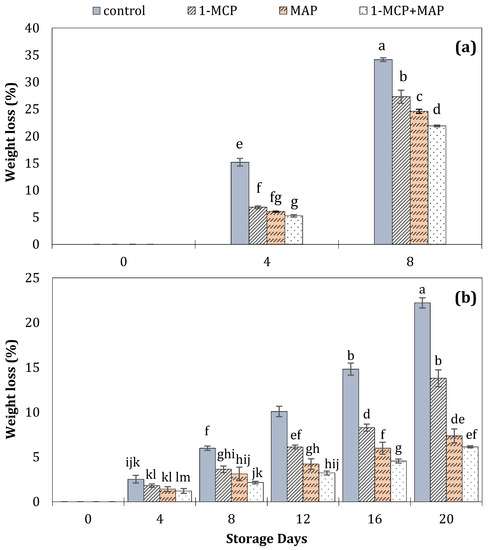
Figure 1.
Effect of 1-methylcyclopropene (1-MCP) and/or modified atmosphere packaging (MAP)on weight loss (%) of okra during storage at (a) ambient (27 ± 2 °C) and (b) cold (7 ± 1 °C) temperatures. The values indicate mean (±) standard deviation. According to the Tukey test, the bars with different letters represent the significance level with each other at p ≤ 0.05.
Figure 1b shows that lowering the storage temperature reduces the weight reduction and 1-MCP + MAP was most effective (6.13 ± 0.22%) in weight retention. The same was observed during okra storage at ambient (24 ± 2 °C) and cold temperature (5 ± 1 °C) [39]. Moreover, 1-MCP acts as an ethylene inhibitor, thus it reduces the changes linked with the ripening process, and in return, fruits remain fresh for a longer time period [20,44]. However, modified atmosphere packaging reduces weight loss due to the restrained water vapor diffusion through the plastic films that increase vapor pressure inside packages [32,36]. The efficiency of both 1-MCP and MAP on weight loss reduction is associated with controlled biochemical activities like transpiration and respiration [45].
Moisture content in okra after harvest was recorded at 88.7 ± 0.36%, which was significantly reduced in control samples at the end of storage. The diminution was greater in samples kept at ambient temperature than the cold stored okra. However, after eight days at ambient temperature, MAP and 1-MCP + MAP treated okra showed nearly identical moisture loss pattern, which was 71.21 ± 0.9%, and 72.8 ± 2.2%, respectively at the end of storage, see Figure 2a. Whereas, at cold storage, the minimum moisture loss (82.2 ± 1.1%) was observed in 1-MCP + MAP treated okra followed by MAP (80.1 ± 0.9%) and 1-MCP (76.9 ± 1.2%) after 20 days, shown in Figure 2b. These results show that the 1-MCP with MAP keeps the fruit fresh by maintaining its water content for a longer time period [45]. Although, temperature is the main factor contributing to moisture loss, lowering the temperature of storage led to better moisture retention [39]. Okra stored at high temperature induces weight loss due to excessive moisture loss [46,47].
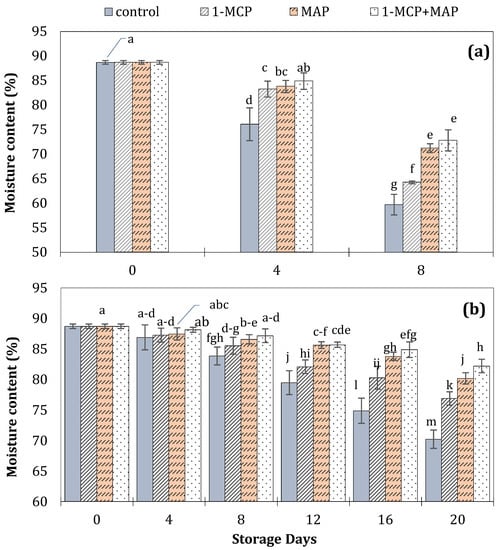
Figure 2.
Effect of 1-MCP and/or MAP on moisture content (%) of okra during storage at (a) ambient (27 ± 2 °C) and (b) cold (7 ± 1 °C) temperatures. The values indicate mean (±) standard deviation. According to the Tukey test, the bars with different letters represent the significance level with each other at p ≤ 0.05.
Firmness is another freshness indicator that determines the quality of okra as loss in firmness is assessed as a sign of senescence. According to the results presented in Figure 3a,b, okra firmness was retained significantly (p ≤ 0.05) when treated with the 1-MCP and/or MAP, however, it was more obvious in the samples treated with 1-MCP + MAP. The firmness of the okra treated with 1-MCP + MAP was 0.69 ± 0.04 kg at ambient temperature, which decreased to 0.47 ± 0.01 kg at ambient temperature during eight days of storage. Similarly, fruit firmness retention with the application of 1-MCP has also been reported in plum, avocado, and eggplant [20,27,39,44]. The reduction in fruit firmness with the 1-MCP application was due to the decline in ethylene production and the fruit softening enzymatic activities [20,44,45]. Additionally, okra firmness was retained by reducing storage temperature and the application of 1-MCP treatment [23]. Both 1-MCP and MAP inhibited the softening of pear and plum fruit during cold storage. During fruit softening, the fruit passes through different compositional changes that reduce its ascorbic acid content [48]. According to Table 2, the treatment effect with storage time and temperature showed a highly positive correlation between fruit firmness and mucilage viscosity (R = 0.99).
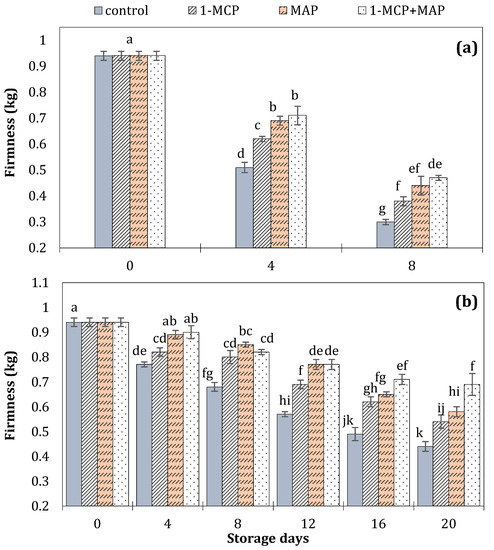
Figure 3.
Effect of 1-MCP and/or MAP on firmness (kg) of okra during storage at (a) ambient (27 ± 2 °C) and (b) cold (7 ± 1 °C) temperatures. The values indicate mean (±) standard deviation. According to the Tukey test, the bars with different letters represent the significance level with each other at p ≤ 0.05.

Table 2.
Pearson correlation coefficient of the physicochemical characteristics of the okra.
Mucilage viscosity is an important quality attribute that accounts for consumer appeal [49]. Mainly, consumers show strong intent to purchase highly viscous pods because of their use as a thickener for stews and soups [50]. Okra mucilage is usually present in the pod walls and is a water-soluble polysaccharide formed by large molecules of sugars that are associated with minerals and proteins [8]. Figure 4a,b shows okra specimens at cold storage showed a less severe decline in comparison with the ambient stored pods and this decline increases with the increase in storage period. This reduction in viscosity is due to the metabolic activities that breakdown polysaccharide chains during the storage period. Fresh produce respire during storage which results in the production of carbon dioxide and water and, as mucilage is soluble in water, thereby, its viscosity decreases during this biological process [51]. Although, low-temperature storage slows down the metabolic processes of the okra causing less reduction in viscosity. The highest mucilage viscosity was observed for 1-MCP + MAP and that is mainly due to the controlled metabolic activities, see Figure 4a,b.
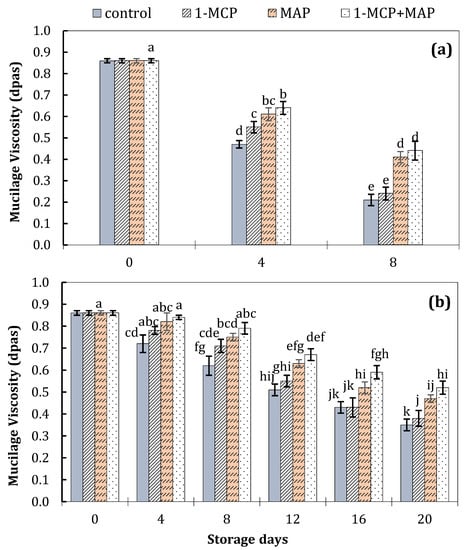
Figure 4.
Effect of 1-MCP and/or MAP on mucilage viscosity (dPas) of okra during storage at (a) ambient (27 ± 2 °C) and (b) cold (7 ± 1 °C) temperatures. The values indicate mean (±) standard deviation. According to the Tukey test, the bars with different letters represent the significance level with each other at p ≤ 0.05.
The ascorbic acid is a nutritional and quality index for okra [47]. It is a water-soluble antioxidant that usually decreases with the increase in light intensity, storage temperature, and storage period [25]. Table 3 shows the level of ascorbic acid in okra decreased with the increase in storage temperature and storage period. The initial ascorbic acid content of okra after harvest was 21.6 ± 0.42 mg/100 g that declined over storage time nonetheless, but the diminution was progressively higher in okra stored at ambient temperature especially in untreated (control) pods. Whereas the MAP retained more ascorbic acid than the 1-MCP alone treated samples at both storage temperatures. In a similar way, the concentration of ascorbic acid in okra and broccoli fruits was more retained by MAP at cold storage temperatures [12,32]. In the present study, the results indicated that the 1-MCP combined with MAP was the most effective treatment to maintain an acceptable level of ascorbic acid content throughout the storage period, however, this retention was more obvious in cold-stored samples (Table 3). After 20 days of low-temperature storage, ascorbic acid contents of 1-MCP + MAP was significantly higher (i.e., 18.2 ± 0.42 mg/100 g) as compared with the fruit stored in MAP (i.e., 16.9 ± 0.30 mg/100 g) and 1-MCP without MAP (i.e., 15.3 ± 0.30 mg/100 g). Similarly, in pear during 210 days of cold storage, 1-MCP and MAP were effective to retain the ascorbic acid content [31].

Table 3.
Effects of 1-MCP and/or MAP on ascorbic acid content, hue angle, total change in color (∆E), and browning index (BI) of okra pods.
Retention of bright green color is a primary indicator for quality evaluation of okra in the market [12]. During storage, darkening, or browning of okra pods ridges is a major problem affecting its appearance [39]. The color of okra was assessed in hue angle (h°), the total color change (∆E), and browning index (BI) that was calculated by individually measuring color parameters L, a, and b. According to Table 3, hue angle was rapidly declined in okra specimens stored at ambient temperature, but this decline was less intensive in MAP (i.e., 112.33° ± 0.42) and 1-MCP + MAP (i.e., 113.91° ± 0.52) than the 1-MCP without MAP (i.e., 109.91° ± 0.65). Conversely, a comparatively slight decline in hue angle was observed in 1-MCP with MAP at cold storage, with final values of 115.96° ± 0.49.
On the other hand, a drastic change in total color (∆E) was observed for the okra specimen kept at ambient conditions than the cold stored samples. Less intensive total color change was noticed in 1-MCP with MAP during okra specimen storage at 7 °C. Table 3 shows, the highest value of the browning index was observed in control samples (untreated) at both storage temperatures. During ambient temperature storage, the browning index increased by 270.7% in control pods, compared to an increase by 126–130% in MAP and 1-MCP + MAP treated pods. Likewise, during 20 days of cold storage, the browning index of MAP and 1-MCP + MAP treated samples increased by 32–44% compared to 125.5% in the control.
This less intensive change in color of okra specimen treated with 1-MCP + MAP was may be due to the suppressed ethylene production and controlled respiration rate. Similarly, Chinese pear fruit treated with 1-MCP suppressed ethylene production that reduced the drastic change in bright green color up to some extent of the storage period [52]. Moreover, the rate of chlorophyll degradation in okra was diminished by decreasing the storage temperature and by covering the fruit with PVC film [1]. The bright green color of okra was well retained by 1-MCP during storage at 7 °C [24]. Table 3 shows that the 1-MCP and/or MAP effect with respect to storage temperature and days has a positive correlation between Hue angle and respiration rate (R = 0.94) and browning index and ethylene production (R = 0.91). This relationship between color change and ethylene production has also been reported in the literature for Chinese pear fruits [52].
Okra pods are very sensitive to low-temperature storage. Storage of fruits (or agricultural products) below room temperature for a long period of time after harvesting, results in chilling injury disorder (browning and pitting) on the fruit surface [53]. As shown in Figure 5, chilling injury symptoms were observed in samples kept at 7 °C for 20 days. The pictorial representation of the chilling injury in the okra pod samples indicates that control samples showed the highest level of chilling injury after 20 days of storage at 7 °C.
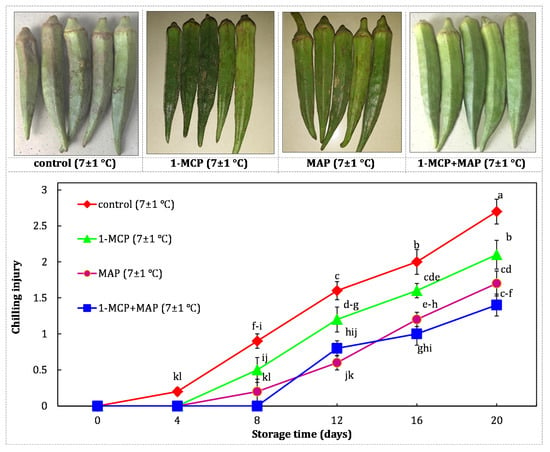
Figure 5.
Effect of 1-MCP and/or MAP on chilling injury of okra during storage at a cold temperature (7 ± 1 °C). The pictorial images are showing chilling injury at the end of storage (i.e., 20th day). The values indicate mean (±) standard deviation. According to the Tukey test, the bars with different letter s represent the significance level with each other at p ≤ 0.0.
As shown in Figure 5, the okra pod samples treated with 1-MCP exhibited a delay in developing chilling injury until the 8th day of the storage period at 7 °C, while 1-MCP + MAP retarded chilling injury symptoms up to the 12th day of the storage period. At the end of storage (i.e., 20 days), chilling injury indices were 2.7 ± 0.17, 2.1 ± 0.20, 1.7 ± 0.17, and 1.4 ± 0.15 in control, 1-MCP, MAP, and 1-MCP + MAP, respectively. The development of chilling injury in fruits is related to a decrease in membrane integrity which occurs due to stress and senescence [24]. As senescence increases with the increase in ethylene production [19], therefore, reducing ethylene production is an effective way to control chilling injury. Moreover, as MAP decreases the ethylene in the atmosphere around the fruit and 1-MCP binds the ethylene receptors [19], therefore, both MAP and 1-MCP can limit the chilling injury stress in fruits. The 1-MCP significantly alleviated the chilling injury in cold-stored citrus and grapefruit [54]. The development of chilling stress in banana was significantly delayed by the presence of modified atmosphere packaging [55]. Similarly, MAP+1-MCP both delayed effectively the chilling injury stress and retained the nutritional quality of peppers and sweet peppers [25,56]. Table 4 shows the effect of different postharvest techniques alleviating chilling injury.

Table 4.
Postharvest technologies alleviating chilling injury in okra pods.
The DPPH radical scavenging activity was calculated after harvest (i.e., 0 days of storage) and at the end of the storage period of both the ambient (i.e., eight days) and cold (i.e., 20 days) stored samples. The DPPH scavenging activity of okra pods at 0-day investigations was 62.4 ± 0.18%. This activity was diminished to 41.3 ± 0.61% and 49.5 ± 0.30% in control samples at ambient and cold storages, respectively. A similar effect was observed for pear fruit, the antioxidant activity was decreased with the increase in storage period [57]. This decrease was less intensive in treated pods than the untreated okra. It has been reported that the decrease in antioxidant activity values was probably due to the degradation of ascorbic acid and phenolic compounds during biosynthesis [58,59]. Figure 6 shows that the 1-MCP + MAP at low-temperature storage maintained well the antioxidant capacity (i.e., 60.7 ± 0.49%). This may be due to the more retention in ascorbic acid comparative to other treated and untreated samples. Figure 7 shows the standard calibration curve for ascorbic acid that was used for the DPPH scavenging activity.
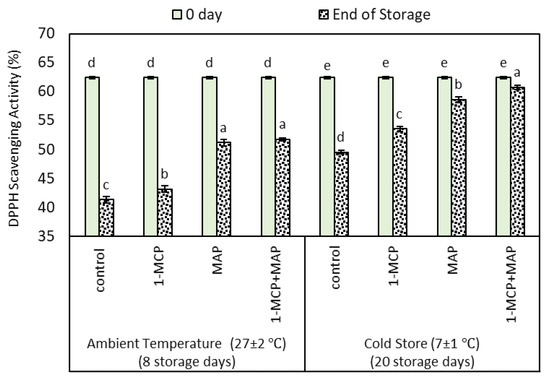
Figure 6.
Effect of 1-MCP and/or MAP on DPPH scavenging activity (%) of okra at 0 days (harvesting day) and end of storage i.e., eight days at ambient (27 ± 2 °C) and 20 days at cold (7 ± 1 °C) storage. The values indicate mean (±) standard deviation. According to the Tukey test, the bars with different letters represent the significance level with each other at p ≤ 0.05.
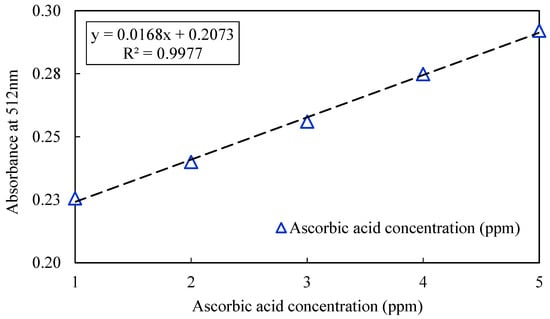
Figure 7.
Calibration curve for ascorbic acid concentration.
Okra is a vegetable with a high respiration rate that is a major cause limiting its shelf-life [17]. As shown in Figure 8a, 1-MCP and MAP treatment suppressed ethylene production for four days at ambient and eight days at cold storage conditions, and afterward, ethylene production attained peak as shown in Figure 8a,b Similarly, in avocado fruit treated with 1-MCP at 0.45 l L−1 for 12 or 24 h and stored at 20 °C, ethylene production was delayed for six and 10 days, respectively [40]. On the other hand, ethylene production of control okra (kept at ambient temperature) increased continuously after harvest and reached a peak value of 1.12 ± 0.05 mg kg−1 h−1 at the end of eight days of storage. However, control samples stored at 7 °C showed a decrease in ethylene production in the initial days of storage and then gained a peak of 0.88 ± 0.03 mg kg−1 h−1 towards the end of the storage period (i.e., 20 days).
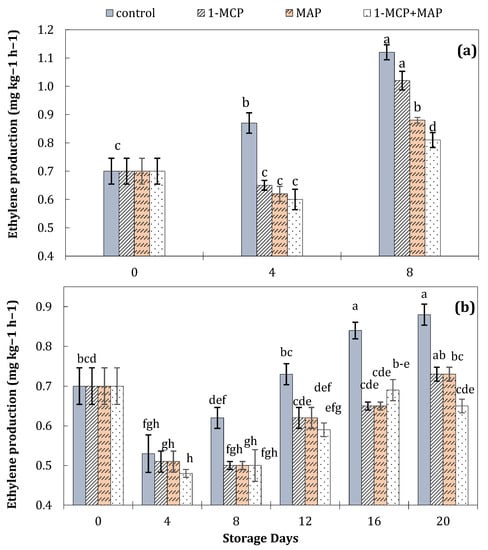
Figure 8.
Effect of 1-MCP with/without MAP on ethylene production of okra during storage at (a) ambient (27 ± 2 °C) and (b) cold (7 ± 1 °C) temperatures. The values indicate mean (±) standard deviation. According to the Tukey test, the bars with different letters represent the significance level with each other at p ≤ 0.05.
The present study shows a similar trend for the respiration rate as was observed for ethylene production. According to Table 2, a positive, as well as highly significant correlation, was observed between ethylene and respiration rate (i.e., R = 0.98). As shown in Figure 9a,b, respiration rate (mg CO2 kg−1 h−1) in okra treated with 1-MCP and MAP alone increased after four (ambient storage) and eight days (cold storage) and attained their peaks at the end of storage. However, okra treated with 1-MCP + MAP peaked on the 16th day of cold storage. Overall, 1-MCP + MAP decreased the rate of respiration and ethylene production most strongly, especially after 20 days of cold storage.
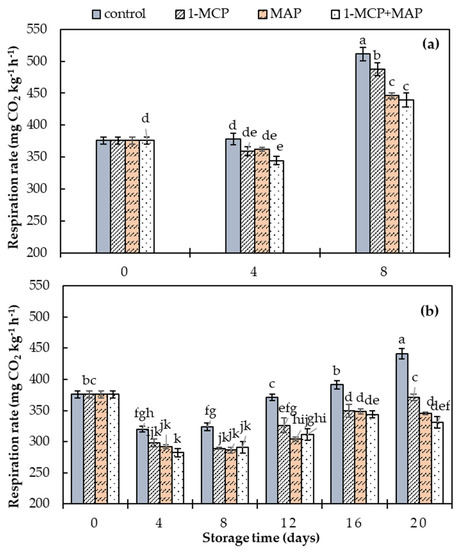
Figure 9.
Effect of 1-MCP with/without MAP on the respiration rate of okra during storage at (a) ambient (27 ± 2 °C) and (b) cold (7 ± 1 °C) temperatures. The values indicate mean (±) standard deviation. According to the Tukey test, the bars with different letters represent the significance level with each other at p ≤ 0.05.
The rate of respiration and ethylene production increases with the increase in temperature [60] and 1-MCP inhibit this increase by binding ethylene receptors that reduce the activity of ripening enzymes [61]. This shows that the storage temperature had a significant effect on the longevity of ripening inhibition after 1-MCP treatment. At high-temperature storage, pear treated with 1-MCP recovered its ripening ability more quickly than the low-temperature storage specimens [62]. Similarly, cold-stored pear and plum treated with 1-MCP and MAP inhibited respiration and ethylene production rates by reducing the activity of ethylene biosynthesis enzymes compared with the fruits stored at the normal atmosphere [31,45].
4. Conclusions
This study aimed to investigate the effects of 1-methylcyclopropene (1-MCP) and modified atmosphere packaging (MAP) on postharvest storage life of okra at two storage conditions; ambient (i.e., 27 ± 2 °C) and low temperature (i.e., 7 ± 1 °C). Results revealed that control (untreated) okra lost its quality within four days because of high moisture and weight loss, while 1-MCP and MAP retained the quality promisingly up to four days at ambient temperature. At low-temperature storage, 1-MCP combined with MAP kept okra quality maintained by controlling its respiration rate and water and weight loss during the storage period (i.e., 20 days). However, control (untreated) okra at low-temperature storage condition lost its quality after eight days due to severe water loss and the vanishing of green color due to chilling injury disorder. Overall, the treatment of okra pods with 1-MCP and MAP was the most effective treatment for maintaining the visual quality as well as inhibiting fruit softening, weight loss, ethylene, and degradation in ascorbic acid and total antioxidant activity.
Author Contributions
Conceptualization, R.K.; data curation, R.K. and I.B.; formal analysis, R.K., H.A., I.B. and M.N.; funding acquisition, M.S., R.R.S. and S.M.I.; investigation, R.K., I.B. and H.A.; methodology, R.K. and Z.Y.; project administration, M.S.; resources, Z.Y., M.N., M.A., R.R.S., N.A. and S.M.I.; software, H.A., Z.Y. and M.N.; supervision, M.S.; validation, M.A., R.R.S., N.A. and Y.Z.; visualization, M.N., M.A., R.R.S., S.M.I., M.A.I. and R.A.; writing—original draft, R.K. and I.B.; writing—review & editing, H.A., M.S., Z.Y., M.N., M.A., R.R.S., S.M.I., N.A., M.A.I., Y.Z. and R.A. All authors have read and agreed to the published version of the manuscript.
Funding
This work was supported by Researchers Supporting Project number (RSP-2020/100), King Saud University, Riyadh, Saudi Arabia.
Acknowledgments
This research work has been carried out in the Post-Harvest Research Centre, Ayub Agriculture Research Institute, Jhang Road, Faisalabad, Pakistan. The authors acknowledge the support from the Researchers Supporting Project number (RSP-2020/100), King Saud University, Riyadh, Saudi Arabia. The authors acknowledge the financial support by the Open Access Publication Fund of the Leibniz Association, Germany and the supports from Benjamin Mahns and Marjan Ahmadi.
Conflicts of Interest
The authors declare no conflict of interest.
References
- Finger, F.L.; Della-Justina, M.E.; Casali, V.W.D.; Puiatti, M. Temperature and modified atmosphere affect the quality of okra. Sci. Agric. 2008, 65, 360–364. [Google Scholar] [CrossRef][Green Version]
- Olivera, D.F.; Mugridge, A.; Chaves, A.R.; Mascheroni, R.H.; Viña, S.Z. Quality attributes of Okra (Abelmoschus esculentus L. Moench) pods as affected by cultivar and fruit size. J. Food Res. 2012, 1, 224. [Google Scholar] [CrossRef]
- Saleem, A.M.; Amjad, M.; Ziaf, K.; Sahi, S.T. Characterization of okra (Abelmoschus esculentus) genotypes for fruit firmness, other horticultural traits and heritability studies. Int. J. Agric. Biol. 2018, 20, 345–352. [Google Scholar] [CrossRef]
- Al-Wandawi, H. Chemical Composition of Seeds of Two Okra Cultivars. J. Agric. Food Chem. 1983, 31, 1355–1358. [Google Scholar] [CrossRef] [PubMed]
- Saleh, M.A.; El-Gizawy, A.M.; El-Bassiouny, R.E.L.; Ali, H.M. Effects of anti-coloring agents on blackening inhibition and maintaining physical and chemical quality of fresh-cut okra during storage. Ann. Agric. Sci. 2013, 58, 239–245. [Google Scholar] [CrossRef]
- Hussein, J.; Ilesanmi, J.; Filli, K.; Sanusi, M. Effects of Drying Methods on the Chemical Properties of Okra (Abelmoschus esculentus L. Moench) Slices. Curr. J. Appl. Sci. Technol. 2018, 26, 1–10. [Google Scholar] [CrossRef]
- Gemede, H.F. Nutritional Quality and Health Benefits of Okra (Abelmoschus esculentus): A Review. J. Food Process Technol. 2015, 6. [Google Scholar] [CrossRef]
- Woolfe, M.L.; Chaplin, M.F.; Otchere, G. Studies on the mucilages extracted from okra fruits (Hibiscus esculentus L.) and baobab leaves (Adansonia digitata L.). J. Sci. Food Agric. 1977, 28, 519–529. [Google Scholar] [CrossRef]
- Sharma, D.K.; Jain, V.K.; Jain, R.; Sharma, N. Postharvest study of okra [Abelmoschus esculentus (L.) moench] fruits and phytopathological effect of associated micro flora. Intl. J. Innov. Res. Rev. 2013, 1, 27–34. [Google Scholar]
- Liu, J.; Yuan, Y.; Wu, Q.; Zhao, Y.; Jiang, Y.; John, A.; Wen, L.; Li, T.; Jian, Q.; Yang, B. Analyses of quality and metabolites levels of okra during postharvest senescence by 1H-high resolution NMR. Postharvest Biol. Technol. 2017, 132, 171–178. [Google Scholar] [CrossRef]
- Dhall, R.K.; Sharma, S.R.; Mahajan, B.V.C. Development of post-harvest protocol of okra for export marketing. J. Food Sci. Technol. 2014, 51, 1622–1625. [Google Scholar] [CrossRef] [PubMed]
- Rai, D.R.; Balasubramanian, S. Qualitative and textural changes in fresh okra pods (hibiscus esculentus L.) under modified atmosphere packaging in perforated film packages. Food Sci. Technol. Int. 2009, 15, 131–138. [Google Scholar] [CrossRef]
- Ribeiro, F.C.S.; Silva, T.P.; Neves, L.L.M.; Finger, F.L. Hydrothermal treatment minimizes the effects of refrigeration in okra fruits. Hortic. Bras. 2017, 35, 499–506. [Google Scholar] [CrossRef]
- Taain, D.A.; Jasim, A.M.; Al-Hij, M.J.H.H. A study of storage behavior of okra fruits. Int. J. Farming Allied Sci. 2014, 3, 760–766. [Google Scholar]
- Carvajal, F.; Martinez, C.; Jamilena, M.; Garrido, D. Differential response of zucchini varieties to low storage temperature. Sci. Hortic. 2011, 130, 90–96. [Google Scholar] [CrossRef]
- Degl’Innocenti, E.; Pardossi, A.; Tognoni, F.; Guidi, L. Physiological basis of sensitivity to enzymatic browning in ‘lettuce’,‘escarole’and ‘rocket salad’when stored as fresh-cut products. Food Chem. 2007, 104, 209–215. [Google Scholar] [CrossRef]
- Boontongto, N.; Srilaong, V.; Uthairatanakij, A.; Wongs-Aree, C.; Aryusuk, K. Effect of methyl jasmonate on chilling injury of okra pod. Acta Hortic. 2007, 746, 323–327. [Google Scholar] [CrossRef]
- Lin, Z.; Zhong, S.; Grierson, D. Recent advances in ethylene research. J. Exp. Bot. 2009, 60, 3311–3336. [Google Scholar] [CrossRef] [PubMed]
- Pesis, E.; Ackerman, M.; Ben-Arie, R.; Feygenberg, O.; Feng, X.; Apelbaum, A.; Goren, R.; Prusky, D. Ethylene involvement in chilling injury symptoms of avocado during cold storage. Postharvest Biol. Technol. 2002, 24, 171–181. [Google Scholar] [CrossRef]
- Jeong, J.; Huber, D.J.; Sargent, S.A. Influence of 1-methylcyclopropene (1-MCP) on ripening and cell-wall matrix polysaccharides of avocado (Persea americana) fruit. Postharvest Biol. Technol. 2002, 25, 241–256. [Google Scholar] [CrossRef]
- In, B.C.; Strable, J.; Binder, B.M.; Falbel, T.G.; Patterson, S.E. Morphological and molecular characterization of ethylene binding inhibition in carnations. Postharvest Biol. Technol. 2013, 86, 272–279. [Google Scholar] [CrossRef]
- Candan, A.P.; Graell, J.; Larrigaudiere, C. Postharvest quality and chilling injury of plums: Benefits of 1-methylcyclopropene. Span. J. Agric. Res. 2011, 9, 554. [Google Scholar] [CrossRef]
- JIA, X.; WANG, W.; DU, Y.; TONG, W.; WANG, Z.; Gul, H. Optimal storage temperature and 1-MCP treatment combinations for different marketing times of Korla Xiang pears. J. Integr. Agric. 2018, 17, 693–703. [Google Scholar] [CrossRef]
- Huang, S.; Li, T.; Jiang, G.; Xie, W.; Chang, S.; Jiang, Y.; Duan, X. 1-Methylcyclopropene reduces chilling injury of harvested okra (Hibiscus esculentus L.) pods. Sci. Hortic. 2012, 141, 42–46. [Google Scholar] [CrossRef]
- Tan, C.K.; Ali, Z.M.; Ismail, I.; Zainal, Z. Effects of 1-methylcyclopropene and modified atmosphere packaging on the antioxidant capacity in pepper “kulai” during low-temperature storage. Sci. World J. 2012, 2012. [Google Scholar] [CrossRef] [PubMed]
- Faasema, J.; Alakali, J.S.; Abu, J.O. Effects of storage temperature on 1-methylcyclopropene-treated mango (mangnifera indica) fruit varieties. J. Food Process. Preserv. 2014, 38, 289–295. [Google Scholar] [CrossRef]
- Massolo, J.F.; Concellón, A.; Chaves, A.R.; Vicente, A.R. 1-Methylcyclopropene (1-MCP) delays senescence, maintains quality and reduces browning of non-climacteric eggplant (Solanum melongena L.) fruit. Postharvest Biol. Technol. 2011, 59, 10–15. [Google Scholar] [CrossRef]
- Sultan, M.; Miyazaki, T.; Mahmood, M.H.; Khan, Z.M. Solar assisted evaporative cooling based passive air-conditioning system for agricultural and livestock applications. J. Eng. Sci. Technol. 2018, 13, 693–703. [Google Scholar]
- Mahmood, M.H.; Sultan, M.; Miyazaki, T. Significance of Temperature and Humidity Control for Agricultural Products Storage: Overview of Conventional and Advanced Options. Int. J. Food Eng. 2019, 15. [Google Scholar] [CrossRef]
- Nath, A.; Deka, B.C.; Singh, A.; Patel, R.K.; Paul, D.; Misra, L.K.; Ojha, H. Extension of shelf life of pear fruits using different packaging materials. J. Food Sci. Technol. 2012, 49, 556–563. [Google Scholar] [CrossRef]
- Li, F.; Zhang, X.; Song, B.; Li, J.; Shang, Z.; Guan, J. Combined effects of 1-MCP and MAP on the fruit quality of pear (Pyrus bretschneideri Reld cv. Laiyang) during cold storage. Sci. Hortic. 2013, 164, 544–551. [Google Scholar] [CrossRef]
- Serrano, M.; Martinez-Romero, D.; Guillén, F.; Castillo, S.; Valero, D. Maintenance of broccoli quality and functional properties during cold storage as affected by modified atmosphere packaging. Postharvest Biol. Technol. 2006, 39, 61–68. [Google Scholar] [CrossRef]
- Sultan, M.; Miyazaki, T. Energy-Efficient Air-Conditioning Systems for Nonhuman Applications. In Refrigeration; Ekren, O., Ed.; IntechOpen Limited: London, UK, 2017. [Google Scholar]
- Hardenburg, R.E.; Watada, A.E.; Wang, C.Y. The Commercial Storage of Fruits, Vegetables, and Florist and Nursery Stocks; US Department of Agriculture, Agricultural Research Service: Beltsville, MD, USA, 1986.
- Perkins-Veazie, P.; Collins, J.K. Cultivar, packaging, and storage temperature differences in postharvest shelf life of okra. Horttechnology 1992, 2, 350–352. [Google Scholar] [CrossRef]
- Babarinde, G.O.; Fabunmi, O.A. Effects of packaging materials and storage temperature on quality of fresh okra (Abelmoschus Esculentus) fruit. Agric. Trop. Subtrop. 2009, 42, 151–156. [Google Scholar]
- Baxter, L.; Waters, L. Controlled atmosphere effects on physical changes and ethylene evolution in harvested okra. HortScience 1990, 25, 92–95. [Google Scholar] [CrossRef]
- Saltveit, M.E. A summary of CA requirements and recommendations for vegetables. In Proceedings of the VIII International Controlled Atmosphere Research Conference, Rotterdam, The Netherlands, 10 March 2003; Volume 600, pp. 723–727. [Google Scholar]
- Gundewadi, G.; Rudra, S.G.; Sarkar, D.J.; Singh, D. Nanoemulsion based alginate organic coating for shelf life extension of okra. Food Packag. Shelf Life 2018, 18, 1–12. [Google Scholar] [CrossRef]
- Dadalı, G.; Kılıç Apar, D.; Özbek, B. Color change kinetics of okra undergoing microwave drying. Dry. Technol. 2007, 25, 925–936. [Google Scholar] [CrossRef]
- Horwitz, W. Official Methods of Analysis of AOAC International. Volume I, Agricultural Chemicals, Contaminants, Drugs/Edited by William Horwitz; Association of Official Agricultural Chemists AOAC International: Rockville, MD, USA, 2010; ISBN 0935584676. [Google Scholar]
- Öztürk, N. Phenolic composition and antioxidant activity of the different extracts from Thymus longicaulis C Presl. subsp. longicaulis var. longicaulis and T. longicaulis C. Presl. subsp. longicaulis var. subisophyllus growing in Turkey. Pak. J. Pharm. Sci. 2015, 28, 465–472. [Google Scholar] [PubMed]
- Phornvillay, S.; Pongprasert, N.; Wongs-Aree, C.; Uthairatanakij, A.; Srilaong, V. Exogenous putrescine treatment delays chilling injury in okra pod (Abelmoschus esculentus) stored at low storage temperature. Sci. Hortic. 2019, 256, 108550. [Google Scholar] [CrossRef]
- Jeong, J.; Huber, D.J.; Sargent, S.A. Delay of avocado (Persea americana) fruit ripening by 1-methylcyclopropene and wax treatments. Postharvest Biol. Technol. 2003, 28, 247–257. [Google Scholar] [CrossRef]
- Khan, A.S.; Singh, Z. 1-Methylcyclopropene application and modified atmosphere packaging affect ethylene biosynthesis, fruit softening, and quality of “Tegan Blue” Japanese plum during cold storage. J. Am. Soc. Hortic. Sci. 2008, 133, 290–299. [Google Scholar] [CrossRef]
- Indore, H.D.; Garande, V.K.; Dhumal, S.S.; Patgaonkar, D.R.; Patil, V.S.; Sonawane, P.N. Effect of Packaging Materials and Storage Conditions on Shelf Life and Quality of Okra*. Int. J. Adv. Res. 2016, 4, 257–265. [Google Scholar] [CrossRef]
- Cheng, Z.; Gong, X.; Jing, W.; Peng, Z.; Li, J. Quality Change of Postharvest Okra at Different Storage Temperatures. J. Food Eng. Technol. 2018, 7, 43. [Google Scholar]
- Bashir, H.A.; Abu-Goukh, A.-B.A. Compositional changes during guava fruit ripening. Food Chem. 2003, 80, 557–563. [Google Scholar] [CrossRef]
- Adom, K.K.; Dzogbefia, V.P.; Ellis, W.O.; Simpson, B.K. Solar drying of Okra—effects of selected package materials on storage stability. Food Res. Int. 1996, 29, 589–593. [Google Scholar] [CrossRef]
- El-Mahdy, A.R.; El-Sebaiy, L.A. Preliminary studies on the mucilages extracted from Okra fruits, Taro tubers, Jew’s mellow leaves and Fenugreek seeds. Food Chem. 1984, 14, 237–249. [Google Scholar] [CrossRef]
- Gernah, D.I.; Daagema, A.A. Effect of storage conditons on some physico-chemical and microbiological properties of fresh okra (Abelmoschus esculenta) fruits. Curr. Res. J. Biol. Sci. 2012, 4, 444–448. [Google Scholar]
- Cheng, Y.; Dong, Y.; Yan, H.; Ge, W.; Shen, C.; Guan, J.; Liu, L.; Zhang, Y. Effects of 1-MCP on chlorophyll degradation pathway-associated genes expression and chloroplast ultrastructure during the peel yellowing of Chinese pear fruits in storage. Food Chem. 2012, 135, 415–422. [Google Scholar] [CrossRef]
- Baxter, L.; Waters, L. Chemical changes in okra stored in air and controlled atmosphere. J. Am. Soc. Hortic. Sci. 2019, 115, 452–454. [Google Scholar] [CrossRef]
- Dou, H.; Jones, S.; Ritenour, M. Influence of 1-MCP application and concentration on post-harvest peel disorders and incidence of decay in citrus fruit. J. Hortic. Sci. Biotechnol. 2005, 80, 786–792. [Google Scholar] [CrossRef]
- Nguyen, T.B.T.; Ketsa, S.; Van Doorn, W.G. Effect of modified atmosphere packaging on chilling-induced peel browning in banana. Postharvest Biol. Technol. 2004, 31, 313–317. [Google Scholar] [CrossRef]
- Li, X.; Yun, J.; Fan, X.; Xing, Y.; Tang, Y. Effect of 1-methylcyclopropene and modified atmosphere packaging on chilling injury and antioxidative defensive mechanism of sweet pepper. Afr. J. Biotechnol. 2011, 10, 6581–6589. [Google Scholar] [CrossRef]
- Ma, Y.; Yang, M.; Wang, J.; Jiang, C.-Z.; Wang, Q. Application of exogenous ethylene inhibits postharvest peel browning of ‘Huangguan’pear. Front. Plant Sci. 2017, 7, 2029. [Google Scholar] [CrossRef] [PubMed]
- Shah, S.W.A.; Jahangir, M.; Qaisar, M.; Khan, S.A.; Mahmood, T.; Saeed, M.; Farid, A.; Liaquat, M. Storage stability of kinnow fruit (Citrus reticulata) as affected by CMC and guar gum-based silver nanoparticle coatings. Molecules 2015, 20, 22645–22661. [Google Scholar] [CrossRef] [PubMed]
- Emamifar, A.; Kadivar, M.; Shahedi, M.; Soleimanian-Zad, S. Evaluation of nanocomposite packaging containing Ag and ZnO on shelf life of fresh orange juice. Innov. Food Sci. Emerg. Technol. 2010, 11, 742–748. [Google Scholar] [CrossRef]
- Atta-Aly, M.A. Effect of high temperature on ethylene biosynthesis by tomato fruit. Postharvest Biol. Technol. 1992, 2, 19–24. [Google Scholar] [CrossRef]
- Blankenship, S.M. 1-Methyl-cyclopropene: A review. Postharvest Biol. Technol. 2003, 28, 1–25. [Google Scholar] [CrossRef]
- Villalobos Acuña, M.G.; Biasi, W.V.; Mitcham, E.J.; Holcroft, D. Fruit temperature and ethylene modulate 1-MCP response in “Bartlett” pears. Postharvest Biol. Technol. 2011, 60, 17–23. [Google Scholar] [CrossRef]
© 2020 by the authors. Licensee MDPI, Basel, Switzerland. This article is an open access article distributed under the terms and conditions of the Creative Commons Attribution (CC BY) license (http://creativecommons.org/licenses/by/4.0/).